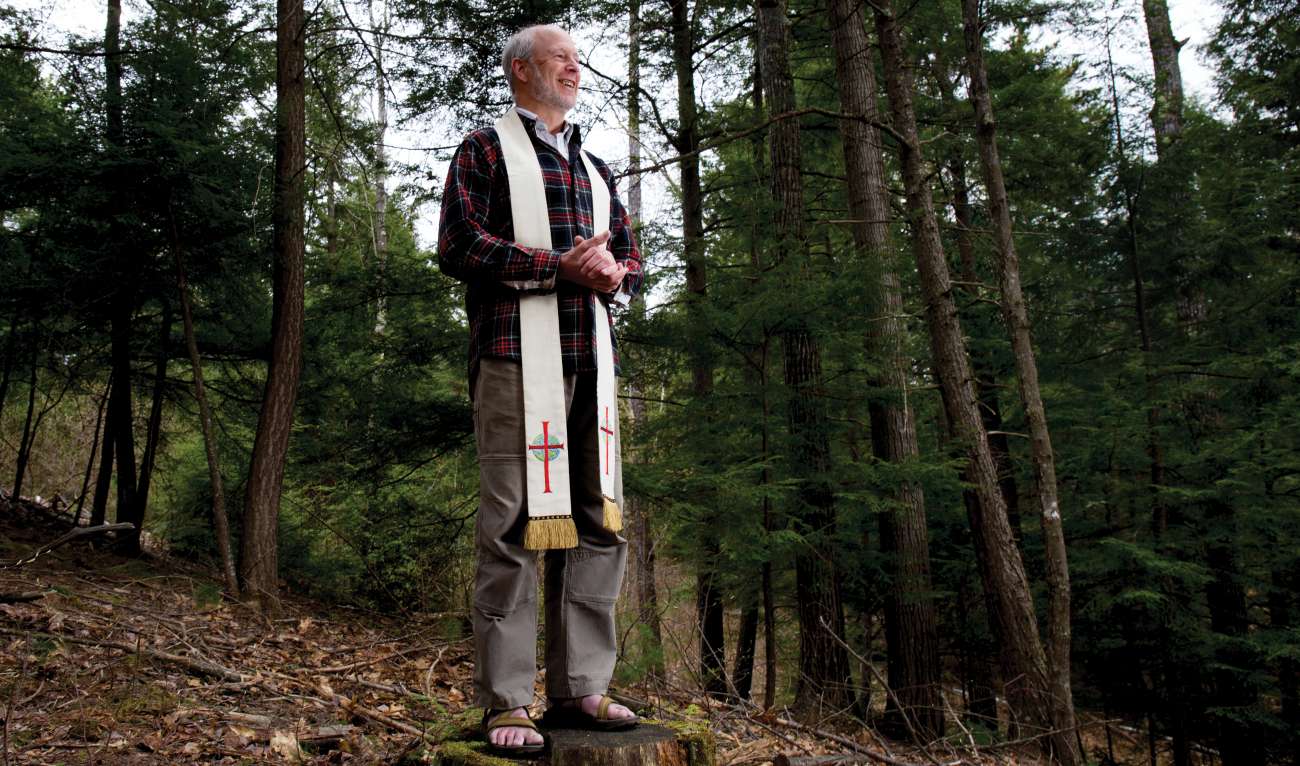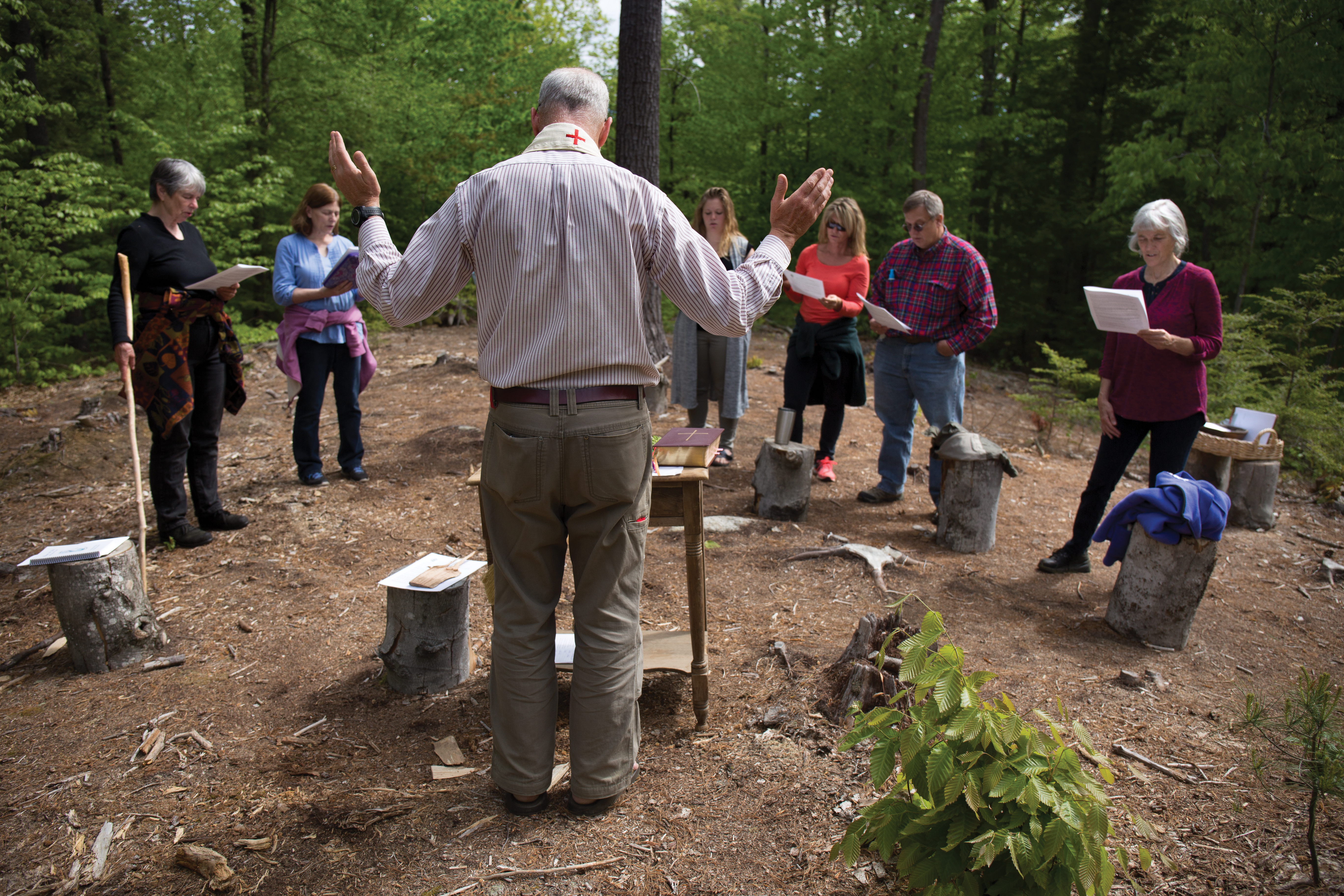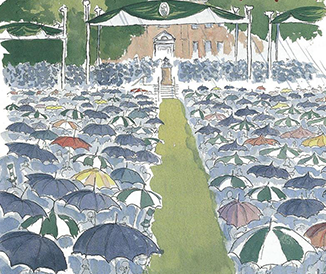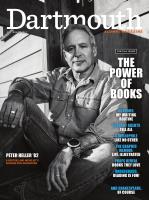Nature Worship
A hemlock stump makes a lowly altar. Weathered, covered with moss, riddled with ant colonies and the claw marks of bears, it’s slowly decaying into earth. Tiny seedlings sprout from its base.
Death. Resurrection.
The Rev. Stephen Blackmer invites his tiny flock—today just a pair of congregants—to wander from the stump and spend 15 or 20 minutes in the woods in contemplation. He charges them to notice what they hear, smell, and feel. He suggests they reflect on the day’s reading from 2 Corinthians:
So we do not lose heart. Even though our outer nature is wasting away, our inner nature is being renewed day by day….For we know that if the earthly tent we live in is destroyed, we have a building from God, a house not made with hands, eternal in the heavens.
The trees around them in the central New Hampshire town of Canterbury would not be confused with the Garden of Eden. Along with scattered young maples and red oaks, skinny, scrappy hemlocks dominate the hummocky stand. Ten years ago these woods were heavily logged. “It was f****** hammered,” says Blackmer, who tends to be un-reverentially profane. “It will take decades to recover.” He bought the cutover land in 2013—106 acres with no buildings—a few months before he was ordained as an Episcopal priest.
He sends his parishioners into the woods with larger questions to contemplate: “What do you do when the sacred grove gets cut down? How do we behave? We pray here with this land as it heals.”
As the trees themselves have done, he asks his followers to bear witness.
Kathryn Wallenstein drove up from Concord, New Hampshire, to be here this afternoon. She says “slowing down” is her favorite part of the service, indeed, of her week. Another of Blackmer’s regulars, a medical technologist named Andrea Chan, says space and quiet are the beauty of Blackmer’s ministry. “I had been searching for a deeper connection to God since I was a girl,” she says. “A lot of us had been. I feel I have a better chance connecting in the woods than in any church I’ve gone to.”
The congregants return with humble offerings for the lowly altar: bits of fern, lichen, tender bright-green hemlock needles. Blackmer arranges them artfully on the stump. An observer arriving at this moment might confuse the ritual for one that is pagan. Blackmer administers the holy sacrament of Communion, pouring the wine from a Nalgene water bottle. He offers a piece of bread and the last splash of wine to the base of the stump, to the earth itself.
Blackmer’s chinstrap beard is trim, both austere and mischievous, like a leprechaun’s. His light-blue eyes, crow’s feet bunching at their corners, convey weariness and compassion. He wears a short-sleeved shirt, work pants, sandals. He drapes around his neck a handmade stole embroidered with a tree and other nature symbols, the only indication that he’s a man of the cloth.
His church is not a standard house of worship made with hands. It’s a scarred, recovering woodlot. He conducts his services outside, year-round, in all weather. He calls it the Church of the Woods.
The tiny turnout this afternoon recalls his first months in 2014, when he held services every other week and occasionally found himself alone on a Sunday, preaching to the birds. Attendance blossomed, boosted in part by fascination from the media, including a front-page article in the Concord Monitor, coverage in The Boston Globe, and a PBS documentary. A 2016 feature in Harper’s Magazine introduced the Church of the Woods to a national audience and positioned Blackmer not as an earth-worshipping druid, but as a leader solidly in a Christian faith tradition. Membership in the church swelled to 50 or 60 regular and semi-regular attendees, and curious visitors began showing up from out of state.
Still, afternoon services on warm summer days are a tough draw.
To those familiar with his life, the notion of Steve Blackmer wearing vestments and reading from the Bible would seem as far-fetched as a hundred-acre woods serving as an Episcopal church. An atheist for as long as he can remember, Blackmer has not only embraced Christianity but become a leader in a national spiritual movement. A career environmentalist, he has turned away from saving land toward the more difficult work of salvation. In those seeming contradictions, amid the escalating destruction of natural habitat and the irreversible extinction of species, Blackmer is attempting, in his words, “to come to terms with an almost overwhelming sense of grief and somehow find hope.”
“Every time we interact with the creation is a sacred act.”
When he graduated from Dartmouth, Blackmer felt called not to God but to conservation, though he had no clear map of what that looked like. He felt his way along a path of his own making, through summer work with the Maine Forest Service and a forestry degree from Yale, eventually becoming founding director of the Northern Forest Center, a nonprofit dedicated to sustaining the forests of northern New England and upstate New York.
He married a fellow environmentalist, Kelly Short, who became stepmother to his two children.
In his work he was patient—and good at recognizing when to quickly say yes. During a quarter-century of environmental activism, he built alliances and had a hand in improving forestry practices and preserving 3 million acres of North Country forest. But, increasingly, he had the unsettling feeling that the work he was so deeply engaged in—and that of the environmental movement as a whole—would never be enough. “I started to realize that direct advocacy was triage,” he says. “Maybe heroic surgery. But it wasn’t addressing underlying causes or getting at wellness.”
En route to a leadership workshop in Europe in the fall of 2007, Blackmer found himself in Belgium with time on his hands. A dome standing out among the angular Brussels rooftops drew his attention. It was a Catholic church, funky, not fancy, with tapestries on the walls lettered in Arabic and Hebrew. It housed a soup kitchen. Walking in, he had a mystical experience. “It was the first time in my life I had ever intentionally entered a church,” he says. “I remember thinking, I need to be here. I want what happens here.”
Flying to a layover in Dublin on his way home, Blackmer looked out at the Irish Sea and noted that the cloud cover had given way to bright sunshine. On the approach he saw the tall tower of the airport chapel. What happened next upended his life. “I’d always had little use for righteous, anti-science Christians who stand in the way of saving our planet,” he says. “I’d grown up without religion. None. Zero. But coming into Dublin I heard a voice—heard it in my heart, as much as my head: You will be a priest.”
Disoriented, Blackmer walked outside to get some fresh air. He automatically headed toward the sunlit side of the terminal. Then he stopped, reconsidered, and meandered through the shade. He found himself at the building whose steeple he had seen. Our Lady Queen of Heaven. He entered the sanctuary and sat for more than an hour. “I thought, What the hell am I going to tell Kelly?”
Blackmer uses the Greek word kairos to help understand his life. “It means ‘time,’ ” he explains, “as in ‘the time has come’ or, put another way, ‘the opportune moment.’ ”
During the next few years Blackmer would recall experiences he couldn’t explain and hadn’t known what to do with. One of the earliest came during a foreign study abroad as a Dartmouth student. Visiting a ruined abbey in southern France, Blackmer sat in the middle of the cloister beneath an ancient cedar of Lebanon. Emotions rushed through him. He dismissed the feelings and mostly forgot about them, though he kept a cone from the tree. (It sits today on a windowsill near his writing desk.) He had subsequently experienced similar waves of inarticulate emotion during times he was alone in nature, including, powerfully, during a fast in the Inyo Mountains of California in 2005. But the voice over Dublin and the feelings in the churches were too obvious to ignore. “I realized I was being called into the presence of the divine,” he says. “The time had come.”
He told his wife as soon as he got home from Brussels.
“Oh, that makes sense,” she replied, surprising him. “You’ve been preaching for years. But do you really have to quit your job?”
He gave notice to his board of directors three weeks later and stumbled, at 50, onto another, uncertain path of his own making. He walked away from work he cared about and was good at, at a time when he was finally earning a decent salary, toward some version of a Christian faith that he had disdained his entire life and whose followers had been taught for millennia that human beings should reign over the fish of the sea and the fowl of the air, whose focus was not tending to a heaven on earth but achieving eternal life in the hereafter.
For the first time, Blackmer opened a Bible. He was surprised to see that nature and wilderness were recurring themes in scripture. Jesus regularly retreated into groves and orchards in contemplation. Trees played a central role. The Bible begins in the Garden of Eden with the tree of life and the tree of the knowledge of good and evil. It ends with the tree of life in the Book of Revelation. Deeply rooted, their branches outstretched to the sky, trees brought earthly and heavenly realms together. “Even the hinge in the understanding between Old and New Testaments is a tree,” says Blackmer. “Jesus on the cross, on a tree stripped of its healing leaves.”
Blackmer read widely and sought counsel with Christians who might find common ground. He had deep conversations with one of his closest friends, Mark Kutolowski ’99, a lay Benedictine oblate who leads spiritually focused retreats and wilderness trips from his home in the Upper Valley. He talked with Brendan Whittaker, an Episcopal pastor and retired forester who had served as Vermont’s first secretary of environmental conservation. He got to know the Rev. Robert Hirschfeld ’83, an Episcopal priest serving in western Massachusetts who is married to Polly Ingraham ’79.
In Blackmer’s mind, an overlapping understanding gradually crystalized. It seemed to him that Christian tradition had lost its primal connection to the natural world. It had turned almost completely to artifice, art, music, man-made symbols, and sanctuaries as ways of finding God. Even as an “eco-spirituality” movement had slowly gained traction during the past 40 years, messages of Christian environmentalism and stewardship remained the province of sermons and teachings, not physical places of worship.
At the same time, the environmental community had become skilled at communicating in scientific and technological terms, in political terms, in terms that provoked fear and despair, but lacked language that moved the spirit. “Environmental activists are really good at placing blame on others,” he says. “On polluters, on corporations, on government—but they don’t do a good job inspiring people to look deeply within themselves.”
In Blackmer a conviction took shape: For our world to be saved—for climate change to be slowed, the rates of extinction slowed, the destruction of habitat slowed—human beings needed to reorient their relationship to the earth. People needed to believe in their souls that the earth itself was sacred. “Without that inward transformation,” Blackmer says, “no amount of politics, technology, economics, or conservation will ever be enough.”
Thinkers and religious leaders across many faiths had long talked about the importance of living in “right relationship” with God’s creation. But the stakes, in Blackmer’s calculation, had become existential. Faith needed to make room for the earth to participate in eternity, not remain separate. For that transformation to take root, Blackmer began to sense that people needed to interact directly with the creation, needed to not only revere the outdoors but worship in it. “Change the space, and everything else shifts,” he says.
He edged closer to a comfort with the Episcopal tradition, one whose sacraments welcomed all people into its leadership. “The voice had clearly said I was to be a priest,” he notes. “It didn’t say, ‘Have you ever considered a career in the ministry?’ ”
His calling would integrate his first career with the one he now struggled to understand. He would be an Episcopal priest. Nature would be his church. He had no clear map of what that looked like.
In order to attend seminary, Blackmer first had to receive the blessing of an Episcopal bishop. (“I’m 53 years old and I need f****** permission to go to graduate school! Can you believe that?” he says.) He turned to Gene Robinson, the first openly gay Episcopal priest. Meeting in 2009 in Robinson’s office in Concord, Blackmer said, “I’m called to be an eco-priest. I don’t know what that is.”
“That’s why we need you,” Robinson answered. “Your charge is to go figure that out.”
Blackmer chose to attend the Yale Divinity School because it was one of the few ordination-track options within driving distance of his New Hampshire home. The choice was a natural fit. He already had a master’s from Yale’s forestry school. The divinity school offered a concentration in religion and environment, with coursework in eco-theology; eco-spirituality; eco-feminism; theologies of embodiment, place, land, race, and indigeneity; environmental ethics; liturgy and creation; and cosmology and ecology.
In 2013, a year before he succeeded Gene Robinson as the bishop of the Episcopal Church of New Hampshire, Hirschfeld ordained Blackmer. The following year Blackmer started the Church of the Woods. His church would maintain an Episcopal affiliation, becoming one of the state’s 46 parishes. Hirschfeld called the new church a “missional community,” an apostolic church in the spirit of the wandering apostles, indeed, the wandering Christ, “sent outside the comfort of our own walls.” But the Church of the Woods would be legally and financially independent, nondenominational, open to all comers.
Blackmer would preside over weddings and funerals and baptisms, as necessary, but he made it clear to Hirschfeld that relationship to nature would be at the center of his preaching, that the word of God he most fervently wanted to spread was: Every time we interact with the creation is a sacred act. He would not only minister to wounded souls. He would also pray in the presence of the wounded earth.
Approaching his fifth year of ministry, Blackmer has no metrics for measuring the success of his new work. In a sense, he is preaching to the choir: Most of those drawn to the Church of the Woods are environmentally aware, stewardship-minded people already committed to recycling and renewables and small carbon footprints. A few dozen parishioners standing around a hemlock stump in the New Hampshire woods is a small choir.
How much difference does Blackmer think he can really make?
“I am answering a deeply personal call,” he says. “Fulfilling that duty is success enough.” As it says in Matthew 18:20, “For where two or three gather in my name, there am I with them.”
In another sense, Blackmer is still the same ambitious environmentalist with strategic planning, marketing, and networking skills. He has created a nonprofit to govern his church, Kairos Earth, with five full-time staff, a national board of directors, an annual operating budget of $378,000, and a website. He plans to build a meetinghouse in the woods—not for services, but for teaching space, to spread Church of the Woods concepts through workshops and seminars.
He travels around the country to meet with others interested in creating nature-focused churches. (Last year, he co-led a service among the Douglas firs and big-leaf maples of Forest Park in Portland, Oregon.) He is spearheading an alliance, the Wild Church Network, to engage people of all faiths at the intersection of religion and conservation. Twenty-five pastors have signed up for the network’s first conference, scheduled for June in Wisconsin. The stirrings of a movement. Not 3 million acres at a time, but one soul at a time.
“Counting the number of people who show up on a Sunday in Canterbury isn’t the way to measure the reach of Steve’s ministry anyway,” says Hirschfeld. “In fact, the kind of thinking that even worries about numbers is what Steve is trying to change. There are other ways to measure the work of the spirit. It’s not about the greening of the church. It’s about bringing a spiritual sense into the environmental movement. That’s where you’ll see Steve’s influence.”
Jim Collins, a former editor of this magazine, is a frequent contributor to DAM. He lives in the state of Washington.














